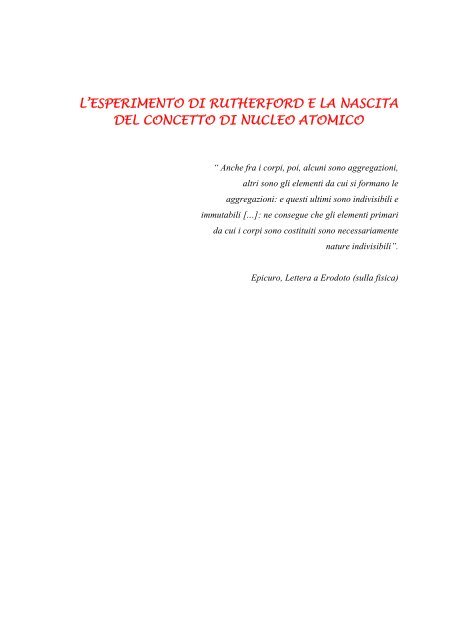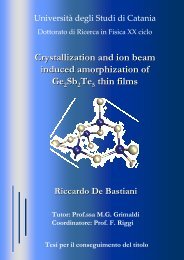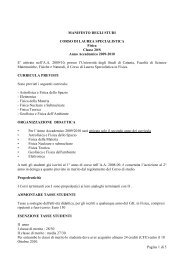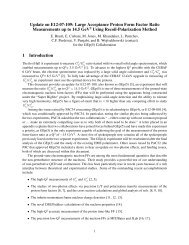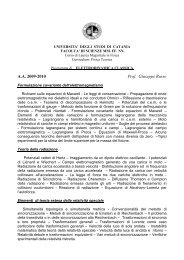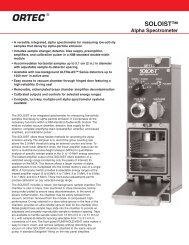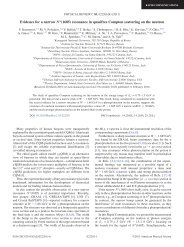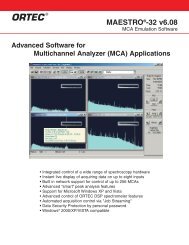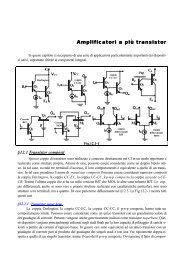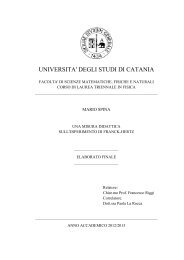L'esperienza di Rutherford.pdf - Dipartimento di Fisica e Astronomia ...
L'esperienza di Rutherford.pdf - Dipartimento di Fisica e Astronomia ...
L'esperienza di Rutherford.pdf - Dipartimento di Fisica e Astronomia ...
You also want an ePaper? Increase the reach of your titles
YUMPU automatically turns print PDFs into web optimized ePapers that Google loves.
L’ESPERIMENTO DI RUTHERFORD E LA NASCITA<br />
DEL CONCETTO DI NUCLEO ATOMICO<br />
“ Anche fra i corpi, poi, alcuni sono aggregazioni,<br />
altri sono gli elementi da cui si formano le<br />
aggregazioni: e questi ultimi sono in<strong>di</strong>visibili e<br />
immutabili […]: ne consegue che gli elementi primari<br />
da cui i corpi sono costituiti sono necessariamente<br />
nature in<strong>di</strong>visibili”.<br />
Epicuro, Lettera a Erodoto (sulla fisica)
In<strong>di</strong>ce<br />
1 Introduzione pag 3<br />
2 Le ricerche <strong>di</strong> <strong>Rutherford</strong> pag 5<br />
3 Lo scattering delle α e l’esperimento <strong>di</strong> Geiger e Marsden pag 6<br />
4 L’interpretazione <strong>di</strong> <strong>Rutherford</strong>: l’ipotesi del nucleo pag 9<br />
5 La teoria della <strong>di</strong>ffusione <strong>di</strong> <strong>Rutherford</strong> pag 11<br />
6 Le conferme sperimentali <strong>di</strong> Geiger e Marsden pag 19<br />
7 Le ricerche successive e la nascita della fisica nucleare pag 22<br />
Bibliografia pag 25<br />
1
L’esperienza <strong>di</strong> <strong>Rutherford</strong> e la nascita del concetto <strong>di</strong><br />
nucleo atomico<br />
1 Introduzione<br />
Nel 1908 Ernest <strong>Rutherford</strong> ricevette il Premio Nobel per la chimica. La nota ufficiale<br />
della premiazione recitava:<br />
“…per le sue ricerche sulla <strong>di</strong>sintegrazione degli elementi e sulla chimica delle<br />
sostanze ra<strong>di</strong>oattive”.<br />
Negli anni <strong>di</strong> lavoro alla McGill University, egli aveva scoperto che l’elemento<br />
ra<strong>di</strong>oattivo Torio emetteva un gas che era a sua volta ra<strong>di</strong>oattivo e che, se la<br />
ra<strong>di</strong>oattività <strong>di</strong> questo gas veniva monitorata separatamente da quella del Torio, si<br />
poteva osservare che esso decresceva geometricamente, <strong>di</strong>mezzandosi all’incirca ogni<br />
minuto. Il gas che aveva scoperto era un isotopo instabile del Radon e questa era la<br />
prima determinazione del tempo <strong>di</strong> <strong>di</strong>mezzamento <strong>di</strong> una sostanza ra<strong>di</strong>oattiva [2,3].<br />
I chimici furono <strong>di</strong> certo entusiasti del fatto che <strong>Rutherford</strong> fosse riuscito a realizzare il<br />
loro antico sogno <strong>di</strong> trasformare gli elementi, o almeno a <strong>di</strong>mostrare che tali<br />
trasformazioni possono verificarsi in natura. <strong>Rutherford</strong> stesso, alla cerimonia <strong>di</strong><br />
premiazione, <strong>di</strong>chiarò meravigliato che egli:<br />
2
“…aveva avuto a che fare con molte trasformazioni <strong>di</strong>verse e con <strong>di</strong>versi tempi <strong>di</strong><br />
trasformazione, ma che la più rapida che avesse incontrato era la sua stessa<br />
trasformazione da fisico a chimico”.<br />
Fig 1 Ernest <strong>Rutherford</strong> (1871-1937), il padre della fisica nucleare. Nel 1908 gli fu assegnato il Premio<br />
Nobel per la chimica “[…] per le sue ricerche sulla <strong>di</strong>sintegrazione degli elementi e sulla chimica delle<br />
sostanze ra<strong>di</strong>oattive”.<br />
Ciononostante egli, riconoscente, intitolò la sua relazione ufficiale per la cerimonia <strong>di</strong><br />
premiazione: “La natura chimica delle particelle α prodotte da sostanze ra<strong>di</strong>oattive”.<br />
Egli aveva scoperto che queste particelle sono atomi <strong>di</strong> Elio ionizzati: aveva infatti<br />
sottoposto un gas <strong>di</strong> particelle α raccolte in un contenitore ad una scarica elettrica,<br />
osservando poi il caratteristico spettro <strong>di</strong> emissione dell’atomo <strong>di</strong> Elio [4,16].<br />
3
2 Le ricerche <strong>di</strong> <strong>Rutherford</strong><br />
All’inizio del ‘900 <strong>Rutherford</strong> era il leader mon<strong>di</strong>ale nella fisica delle particelle α. Nel<br />
1906, mentre lavorava alla McGill University, era stato il primo a rivelare piccole<br />
deviazioni delle α al passaggio attraverso la materia. Nel 1907 <strong>di</strong>venne professore<br />
all’Università <strong>di</strong> Manchester dove iniziò a lavorare con Hans Geiger. Un anno prima J.J.<br />
Thomson aveva pubblicato un’articolo in cui proponeva un modello atomico secondo<br />
cui il numero <strong>di</strong> elettroni all’interno <strong>di</strong> un atomo è all’incirca uguale al numero atomico.<br />
Questa teoria prevede che l’atomo sia formato da una sfera <strong>di</strong> carica positiva,<br />
contenente un’eguale quantità <strong>di</strong> carica elettrica negativa sotto forma <strong>di</strong> corpuscoli,<br />
<strong>di</strong>stribuiti uniformemente all’interno della sfera. E’ bene ricordare che, non molto<br />
tempo prima, si pensava che gli atomi potessero contenere migliaia <strong>di</strong> elettroni: si<br />
credeva, infatti, che essi costituissero una frazione consistente della massa atomica.<br />
Fig. 2 Modello atomico <strong>di</strong> Thomson.<br />
<strong>Rutherford</strong> scoprì la deflessione delle particelle α nella materia, quasi per caso, nel<br />
corso dei suoi stu<strong>di</strong> sul rapporto tra la loro carica e la loro massa, per i quali ne<br />
misurava la deflessione in un campo magnetico. Egli rivelava le α facendole incidere su<br />
una lastra fotografica. Ponendo un sottile foglio <strong>di</strong> mica davanti alla pellicola, trovò che<br />
4
l’immagine risultava sfocata ai bor<strong>di</strong>: evidentemente la mica defletteva le particelle α <strong>di</strong><br />
un grado o due. Egli, però, sapeva bene che le α non potevano essere deflesse <strong>di</strong> una<br />
tale quantità dagli elettroni degli atomi, dal momento che il loro peso superava <strong>di</strong> circa<br />
8000 volte quello degli elettroni, che esse erano molto veloci e che ciascun atomo<br />
conteneva poche dozzine <strong>di</strong> elettroni. La massa dell’atomo doveva essere legata in<br />
qualche modo alla carica positiva. Quin<strong>di</strong> egli pensò che dall’analisi <strong>di</strong> queste piccole<br />
deflessioni poteva venire fuori qualche in<strong>di</strong>zio sulla <strong>di</strong>stribuzione delle cariche positive<br />
e della massa all’interno degli atomi. D’altra parte, il campo elettrico generato<br />
dall’atomo, necessario a produrre la deflessione osservata, gli appariva già<br />
sorprendentemente grande.<br />
3 Lo scattering delle α e l’esperimento <strong>di</strong> Geiger e Marsden<br />
Gli esperimenti <strong>di</strong> <strong>Rutherford</strong> sullo scattering delle α furono i primi esperimenti in cui<br />
le singole particelle venivano deflesse e rivelate in maniera sistematica. Questo modo <strong>di</strong><br />
operare è oggi la procedura comunemente usata nella fisica delle particelle. Per ridurre<br />
al minimo la deflessione <strong>di</strong> particelle α causata dalle molecole dell’aria, gli esperimenti<br />
venivano condotti in con<strong>di</strong>zioni <strong>di</strong> vuoto.<br />
Le particelle α provenivano da pochi milligrammi <strong>di</strong> Ra<strong>di</strong>o contenuti nella sorgente,<br />
in<strong>di</strong>cata con R nella figura tratta dall’articolo originale, che recita:<br />
5
"…By means of a <strong>di</strong>aphragm placed at D, a pencil of alpha particles was <strong>di</strong>rected<br />
normally on to the scattering foil F. By rotating the microscope [M] the alpha particles<br />
scattered in <strong>di</strong>fferent <strong>di</strong>rections could be observed on the screen S".<br />
Fig 3 Schematizzazione dell’apparato sperimentale [9].<br />
In realtà realizzare queste osservazioni era molto più <strong>di</strong>fficile <strong>di</strong> quanto possa sembrare.<br />
Una singola particella α incidente sullo schermo <strong>di</strong> solfuro <strong>di</strong> zinco, infatti, provocava<br />
una debole fluorescenza. Questa poteva essere osservata attraverso il microscopio solo<br />
da occhi abituati all’oscurità (dopo mezz’ora al buio completo) e una persona poteva<br />
contare accuratamente i lampi <strong>di</strong> luce per non più <strong>di</strong> un minuto, prima <strong>di</strong> aver bisogno <strong>di</strong><br />
una pausa. Nel corso dell’esperimento furono accumulati dati per centinaia <strong>di</strong> migliaia<br />
<strong>di</strong> conteggi.<br />
Collaboratore <strong>di</strong> <strong>Rutherford</strong> nella fase iniziale <strong>di</strong> questo lavoro fu Hans Geiger, che più<br />
tar<strong>di</strong> avrebbe sviluppato un <strong>di</strong>spositivo in grado <strong>di</strong> rivelare e contare le particelle veloci,<br />
6
ancor oggi utilizzato e conosciuto come contatore Geiger: tantissime ore passate a<br />
fissare lo schermo <strong>di</strong> solfuro <strong>di</strong> zinco nel buio devono aver spinto la sua mente a trovare<br />
un modo migliore.<br />
Nel 1909, uno studente, Ernest Marsden, <strong>di</strong>venne allievo <strong>di</strong> Geiger. Molti anni più tar<strong>di</strong>,<br />
<strong>Rutherford</strong> <strong>di</strong>sse, ricordando quei giorni:<br />
Previsione Risultato<br />
Fig 4 Previsioni e risultato dell’esperimento <strong>di</strong> Geiger e Marsden.<br />
"I had observed the scattering of alpha-particles, and Dr. Geiger in my laboratory had<br />
examined it in detail. He found, in thin pieces of heavy metal, that the scattering was<br />
usually small, of the order of one degree. One day Geiger came to me and said, "Don't<br />
you think that young Marsden, whom I am training in ra<strong>di</strong>oactive methods, ought to<br />
begin a small research?" Now I had thought that, too, so I said, " Why not let him see if<br />
any alpha-particles can be scattered through a large angle?" I may tell you in confidence<br />
that I <strong>di</strong>d not believe that they would be, since we knew the alpha-particle was a very<br />
fast, massive particle with a great deal of energy, and you could show that if the<br />
scattering was due to the accumulated effect of a number of small scatterings, the<br />
chance of an alpha-particle's being scattered backward was very small. Then I<br />
remember two or three days later Geiger coming to me in great excitement and saying<br />
7
"We have been able to get some of the alpha-particles coming backward …" It was<br />
quite the most incre<strong>di</strong>ble event that ever happened to me in my life. It was almost as<br />
incre<strong>di</strong>ble as if you fired a 15-inch shell at a piece of tissue paper and it came back and<br />
hit you".<br />
4 L’interpretazione <strong>di</strong> <strong>Rutherford</strong>: l’ipotesi del nucleo<br />
La retro<strong>di</strong>ffusione delle particelle α si rivelò fatale per il modello atomico <strong>di</strong> Thomson.<br />
Un’assunzione fondamentale <strong>di</strong> quel modello era, infatti, che la carica positiva e la<br />
massa fossero <strong>di</strong>stribuite più o meno uniformemente su tutto il volume dell’atomo, il cui<br />
raggio era stato stimato dell’or<strong>di</strong>ne <strong>di</strong> 10 -10 metri. Non è <strong>di</strong>fficile calcolare l’intensità<br />
del campo elettrico generato da una tale <strong>di</strong>stribuzione <strong>di</strong> carica. E’ il caso <strong>di</strong> ricordare<br />
che questo è il campo che deve produrre la <strong>di</strong>ffusione delle α, dal momento che gli<br />
elettroni sono così leggeri da non poter produrre significative deflessioni su <strong>di</strong> esse.<br />
Nello specifico, consideriamo l’atomo <strong>di</strong> oro, dal momento che il foglio usato da<br />
<strong>Rutherford</strong> era d’oro, dello spessore <strong>di</strong> circa 400 piani atomici. L’atomo <strong>di</strong> oro ha una<br />
carica positiva <strong>di</strong> 79e, bilanciata da quella <strong>di</strong> 79 elettroni, in con<strong>di</strong>zioni normali. Se<br />
trascuriamo questi elettroni, possiamo affermare che una particella α sarà soggetta alla<br />
massima forza elettrica in corrispondenza della superficie della sfera <strong>di</strong> carica positiva:<br />
8
Infatti, al <strong>di</strong> fuori dell’atomo, la forza elettrica repulsiva <strong>di</strong>minuisce col quadrato della<br />
<strong>di</strong>stanza. All’interno dell’atomo, invece, la forza si riduce a zero in corrispondenza del<br />
centro. Quin<strong>di</strong> la forza è massima proprio in corrispondenza della superficie.<br />
Fig 5 Grafico <strong>di</strong> E in funzione <strong>di</strong> r per una sfera uniformemente carica [15]<br />
Poiché le particelle α hanno massa 6.7x10 -27 kg, dalla seconda legge <strong>di</strong> Newton, segue<br />
che la forza elettrica in corrispondenza della superficie dell’atomo è in grado <strong>di</strong> fornire<br />
loro un’accelerazione laterale pari a 5.4x10 20 m/s 2 (molto maggiore <strong>di</strong> g = 9.81m/s 2 ).<br />
Dal momento, però, che le α si muovono alla velocità <strong>di</strong> 1.6x10 7 m/s, tale forza agisce<br />
solo per un breve intervallo <strong>di</strong> tempo, esattamente il tempo necessario alla particella per<br />
attraversare l’atomo, cioè t0 = 2r0/v = 2x10 -10 /1.6x10 7 = 1.25x10 -17 s. La velocità laterale<br />
acquistata da una particella α nell’attraversare un atomo <strong>di</strong> oro sarà data dunque dal<br />
prodotto dell’accelerazione laterale per il tempo <strong>di</strong> attraversamento:<br />
vL = 1.25x10 -17 x5.4x10 20 = 6750 m/s.<br />
Questa velocità è circa 2000 volte più piccola della velocità incidente e può causare<br />
quin<strong>di</strong> solo minuscole deviazioni. Anche se una particella α urtasse 400 atomi <strong>di</strong> oro in<br />
9
successione e se fosse deflessa sempre nella stessa <strong>di</strong>rezione, un evento questo<br />
assolutamente improbabile, la deflessione finale sarebbe all’incirca <strong>di</strong> un grado. Le<br />
retro<strong>di</strong>ffusioni osservate <strong>di</strong> 90 gra<strong>di</strong> e più, dunque, risultavano del tutto inesplicabili,<br />
utilizzando il modello <strong>di</strong> Thomson.<br />
<strong>Rutherford</strong> ragionò su questo problema per alcuni mesi. Egli era stato inizialmente un<br />
sostenitore del modello <strong>di</strong> Thomson, ma in seguito a queste osservazioni si era convinto<br />
che non era possibile, in alcun modo, che esso generasse il campo elettrico necessario a<br />
deflettere le particelle α. Inoltre era <strong>di</strong>fficile che l’atomo potesse contenere una carica<br />
positiva maggiore <strong>di</strong> quella necessaria a compensare gli elettroni ed era ben noto, a quel<br />
tempo, che essi non superavano il centinaio (il valore esatto, <strong>di</strong> 79 elettroni, fu trovato<br />
poo dopo). Come detto, il campo elettrico generato da una sfera uniformemente carica<br />
raggiunge il valore massimo sulla superficie. Quin<strong>di</strong>, per una data carica, supposto che<br />
essa sia <strong>di</strong>stribuita sfericamente, l’unico modo per ottenere un campo elettrico più<br />
intenso è quello <strong>di</strong> comprimerla in una sfera più piccola. <strong>Rutherford</strong> concluse che egli<br />
era in grado <strong>di</strong> spiegare le gran<strong>di</strong> deflessioni subite dalle particelle α nell’attraversare<br />
una lamina d’oro, solo se la carica positiva e la maggior parte della massa dell’atomo<br />
fossero concentrate in una sfera <strong>di</strong> <strong>di</strong>mensioni molto più piccole <strong>di</strong> quelle dell’atomo<br />
stesso.<br />
5 La teoria della <strong>di</strong>ffusione <strong>di</strong> <strong>Rutherford</strong><br />
Benché <strong>Rutherford</strong> dedusse la formula della <strong>di</strong>ffusione nel caso specifico <strong>di</strong> particelle α<br />
incidenti, soggette alla <strong>di</strong>ffusione, in questo paragrafo cercheremo <strong>di</strong> essere un po’ più<br />
generali e assumeremo che la particella incidente abbia una carica ze.<br />
10
Le ipotesi <strong>di</strong> partenza sono le seguenti:<br />
1. Il nucleo bersaglio abbia una massa molto maggiore <strong>di</strong> quella della particella<br />
incidente e quin<strong>di</strong> il rinculo sia trascurabile.<br />
2. Il nucleo bersaglio e la particella incidente abbiano <strong>di</strong>stribuzioni <strong>di</strong> carica<br />
puntiformi, <strong>di</strong> modo che tra loro agisca il potenziale coulombiano<br />
V<br />
() r<br />
2<br />
Zze<br />
= , dove r è la <strong>di</strong>stanza che separa i loro centri.<br />
4πε r<br />
0<br />
3. Non agiscano altre forze oltre a quella dovuta al potenziale coulombiano.<br />
4. Non si verifichino eccitazioni della particella incidente, né <strong>di</strong> quella bersaglio:<br />
l’urto sia elastico.<br />
Fig 6 Orbita <strong>di</strong> una particella incidente con parametro d’impatto b, secondo la teoria della <strong>di</strong>ffusione <strong>di</strong><br />
<strong>Rutherford</strong> [14]<br />
Consideriamo la figura 6. Se la particella incidente non fosse deflessa, essa passerebbe<br />
ad una <strong>di</strong>stanza b, il parametro d’impatto, dal centro (O) del nucleo bersaglio. L’orbita<br />
è, infatti, iperbolica e nel punto D la particella incidente si trova nel punto <strong>di</strong> massimo<br />
avvicinamento, alla <strong>di</strong>stanza d. L’orbita è chiaramente simmetrica rispetto al segmento<br />
OD. Se b fosse zero, la particella incidente si avvicinerebbe al nucleo bersaglio fino alla<br />
11
<strong>di</strong>stanza p (figura 7). A questo punto l’energia cinetica della particella incidente si<br />
trasformerebbe in energia potenziale nel campo coulombiano :<br />
1<br />
2<br />
Zze<br />
4πε<br />
2<br />
2<br />
mv p = (5.1)<br />
0<br />
Fig 7 Orbita <strong>di</strong> una particella incidente con parametro d’impatto zero [14]<br />
STEP 1: trovare la connessione tra b e θ.<br />
Utilizziamo la conservazione del momento angolare, per mettere in relazione la velocità<br />
incidente con la componente della velocità trasversale a OX in X:<br />
2 dϕ<br />
mvb = mr<br />
(5.2)<br />
dt<br />
da cui:<br />
dt dϕ<br />
=<br />
r vb<br />
2 (5.3)<br />
12
Consideriamo adesso la componente del momento lineare in <strong>di</strong>rezione OD. Essa varia<br />
da mv sin ( ϑ 2)<br />
− a mv sin( ϑ 2)<br />
+ . Nel punto X la rate <strong>di</strong> variazione del momento è<br />
uguale alla componente della repulsione coulombiana lungo la <strong>di</strong>rezione OD, da cui:<br />
+∞<br />
∫<br />
−∞<br />
2<br />
2<br />
( Zze 4πε<br />
r ) cos(<br />
)dt<br />
⎛ϑ<br />
⎞<br />
2mv<br />
sin⎜<br />
⎟ =<br />
0 ϕ<br />
⎝ 2 ⎠<br />
Utilizziamo l’equazione (5.3) per cambiare la variabile <strong>di</strong> integrazione dal tempo t in ϕ,<br />
e otteniamo:<br />
⎛ ⎞ Zze<br />
2mv<br />
sin⎜<br />
⎟ =<br />
⎝ 2 ⎠ 4πε<br />
vb<br />
da cui:<br />
ϑ p<br />
tan =<br />
2 2b<br />
2<br />
ϑ −<br />
STEP 2: derivare la sezione d’urto.<br />
0<br />
p mv<br />
2<br />
ϕ=<br />
( π −ϑ<br />
) / 2<br />
∫ cos(<br />
ϕ)<br />
dϕ<br />
=<br />
ϕ=<br />
−(<br />
π −ϑ<br />
) / 2<br />
b<br />
π ϑ / [ sinϕ<br />
] −(<br />
π −ϑ<br />
)<br />
(5.4)<br />
( ) 2<br />
La relazione (5.4) ci <strong>di</strong>ce che quando b decresce, θ cresce. Quin<strong>di</strong> affinché una<br />
particella subisca una <strong>di</strong>ffusione <strong>di</strong> angolo maggiore <strong>di</strong> Θ, il parametro d’impatto b deve<br />
essere minore <strong>di</strong> (p/2)cot(Θ/2). Ciò significa che la particella incidente deve colpire un<br />
<strong>di</strong>sco <strong>di</strong> questo raggio, centrato in O e perpen<strong>di</strong>colare a v. L’area σ, esposta dal nucleo<br />
per una <strong>di</strong>ffusione <strong>di</strong> angolo superiore a Θ, è proprio l’area <strong>di</strong> questo <strong>di</strong>sco:<br />
13<br />
/ 2
σ<br />
( ϑ > Θ)<br />
o, per esteso:<br />
2<br />
p π 2 Θ<br />
= cot<br />
4 2<br />
2<br />
(5.5)<br />
2<br />
π ⎛ 2Zze<br />
⎞ 2 Θ<br />
σ ( ϑ > Θ)<br />
=<br />
cot 2<br />
4 ⎜<br />
4 ⎟<br />
(5.6)<br />
⎝ πε 0mv<br />
⎠ 2<br />
L’area σ è detta sezione d’urto. Essa può essere determinata con una misura <strong>di</strong><br />
attenuazione del fascio <strong>di</strong> particelle incidenti. Consideriamo, per esempio, un fascio <strong>di</strong><br />
protoni <strong>di</strong> intensità I, per cui I protoni cm -2 sec -1 incidono su un bersaglio contenente N<br />
nuclei cm -3 <strong>di</strong> materiale. Uno spessore dx conterrà quin<strong>di</strong> Ndx nuclei al cm 2 e il fascio<br />
incidente sarà attenuato a causa degli urti. La variazione in intensità dI sarà<br />
proporzionale a I e a Ndx:<br />
dI −I<br />
⋅ ⋅ Ndx<br />
= σ (5.7)<br />
dove il fattore <strong>di</strong> proporzionalità σ, avente le <strong>di</strong>mensioni <strong>di</strong> un’area, è proprio la sezione<br />
d’urto del materiale bombardato relativa alle particelle del fascio incidente. Per<br />
comprendere meglio la ragione <strong>di</strong> questo nome, consideriamo la figura 8, in cui è<br />
schematizzato un bersaglio enormemente ingran<strong>di</strong>to, visto dalla <strong>di</strong>rezione <strong>di</strong> incidenza<br />
del fascio. Le macchie irregolarmente <strong>di</strong>sposte raffigurano i nuclei del bersaglio. Il loro<br />
numero è Ndx per cm 2 . L’area da essi occupata è σNdx e, se le particelle che la<br />
14
colpiscono sono rimosse dal fascio, la variazione <strong>di</strong> intensità è effettivamente data<br />
dall’equazione (5.7), la cui integrazione, per σ costante, dà<br />
I<br />
− N ⋅σ<br />
⋅x<br />
( x ) = I ( ) ⋅ e<br />
0 (5.8)<br />
in cui I(0) è l’intensità incidente e x lo spessore attraversato.<br />
1 cm<br />
area = σ<br />
no. = Ndx<br />
Fig 8 Cinque nuclei, ciascuno <strong>di</strong> sezione d’urto σ, sono mostrati in un bersaglio <strong>di</strong> area unitaria. La<br />
probabilità che una particella che attraversa l’area unitaria colpisca un nucleo è pari a σNdx, dove Ndx è il<br />
numero <strong>di</strong> nuclei per area unitaria e σ è la sezione d’urto del processo [13].<br />
STEP 3: derivare la sezione d’urto <strong>di</strong>fferenziale.<br />
Il nostro scopo è calcolare dσ/dΩ, che è la sezione d’urto per unità <strong>di</strong> angolo solido per<br />
un dato angolo θ. L’elemento <strong>di</strong> angolo solido dΩ tra θ e θ + dθ è dato da:<br />
dΩ = 2π sinθ dθ<br />
Quin<strong>di</strong><br />
15
dσ<br />
1 dσ<br />
=<br />
dΩ<br />
2π<br />
sinϑ<br />
dϑ<br />
Il dσ/dθ <strong>di</strong> cui abbiamo bisogno è<br />
2<br />
dσ<br />
⎛ Zze<br />
=<br />
d ⎜<br />
Ω ⎝16πε<br />
0mv<br />
2<br />
2 ⎞<br />
4 ⎟ cos ec<br />
2<br />
⎟<br />
⎠<br />
ϑ<br />
2<br />
( > Θ)<br />
dσ ϑ<br />
dΘ<br />
e dall’equazione (5.6) otteniamo:<br />
(5.9)<br />
La sezione d’urto <strong>di</strong>fferenziale dσ/dΩ può essere determinata misurando il numero <strong>di</strong><br />
particelle <strong>di</strong>ffuse per unità <strong>di</strong> angolo solido in funzione <strong>di</strong> θ, rivelando le particelle<br />
<strong>di</strong>ffuse con un contatore, secondo lo schema <strong>di</strong> figura 9.<br />
I<br />
T<br />
Fig 9 Misura della sezione d’urto <strong>di</strong>fferenziale <strong>di</strong> <strong>di</strong>ffusione per mezzo dell’osservazione delle particelle<br />
<strong>di</strong>ffuse. Con I è in<strong>di</strong>cato il fascio incidente, con T il bersaglio, con θ l’angolo <strong>di</strong> <strong>di</strong>ffusione e con d il<br />
rivelatore [13].<br />
L’equazione (5.9) è la famosa formula <strong>di</strong> <strong>Rutherford</strong> per la sezione d’urto <strong>di</strong>fferenziale<br />
<strong>di</strong> un processo <strong>di</strong> <strong>di</strong>ffusione <strong>di</strong> tipo coulombiano.<br />
16<br />
θ<br />
d
Tale sezione d’urto presenta le seguenti caratteristiche:<br />
• è inversamente proporzionale al quadrato dell’energia cinetica e, quin<strong>di</strong>, alla<br />
quarta potenza della velocità della particella incidente,<br />
• è proporzionale al quadrato della carica della particella incidente e del nucleo<br />
bersaglio,<br />
• è proporzionale a cosec 4 (θ/2).<br />
<strong>Rutherford</strong> pubblicò questa teoria per la prima volta nel 1911 [8] e la confermò<br />
successivamente in un articolo del 1914 [10], in cui fu in grado <strong>di</strong> fornire risultati<br />
significativi sulle <strong>di</strong>mensioni dei nuclei:<br />
“[…] In my previous paper I showed that the nucleus must have excee<strong>di</strong>ngly small<br />
<strong>di</strong>mensions, and calculated that in the case of gold its ra<strong>di</strong>us was not greater then 3 x<br />
10¯ 12 cm. In order to account for the velocity given to hydrogen atoms by the collision<br />
with α particles, it can be simply calculated (see Darwin) that the centres of nuclei of<br />
helium and hydrogen must approach within a <strong>di</strong>stance of 1.7 x 10¯ 13 cm. of each other.<br />
Supposing for simplicity the nuclei to have <strong>di</strong>mensions and to be spherical in shape, it is<br />
clear that the sum of the ra<strong>di</strong>i of the hydrogen and helium nuclei is not greater than 1.7<br />
x 10¯ 13 cm […] It is obvious that the method we have considered gives a maximum<br />
estimate of the <strong>di</strong>mensions of the nuclei, and it is not improbable that the hydrogen<br />
nucleus itself may have still smaller <strong>di</strong>mensions”.<br />
17
6 Le conferme sperimentali <strong>di</strong> Geiger e Marsden<br />
Tra il 1909 ed il 1913, Geiger e Marsden eseguirono una serie <strong>di</strong> esperimenti allo scopo<br />
<strong>di</strong> verificare le ipotesi e la teoria che <strong>Rutherford</strong> in quello stesso periodo andava<br />
affinando, come riportato, in un testo del 1930 intitolato “Ra<strong>di</strong>ations from ra<strong>di</strong>oactive<br />
substances”, da Chadwick, da Ellis e dallo stesso <strong>Rutherford</strong> [12]:<br />
“[…] The first point, the angular <strong>di</strong>stribution of the scattered particles, was tested by<br />
Geiger in some preliminary experiments. He found that the <strong>di</strong>stribution between 30°<br />
and 150° of the particles scattered by a thin gold foil was in agreement with this theory.<br />
Later, a beautiful series of experiments was carried out by Geiger and Marsden, in<br />
which the above conclusions drawn by <strong>Rutherford</strong> from his theory were tested point by<br />
point. They first investigated the variation of scattering of α particles over a wide range<br />
of angles […] By rotating the platform A (figura 3) the α particles scattered in <strong>di</strong>fferent<br />
<strong>di</strong>rections could be observed on the zinc-sulphide screen.<br />
[…] The collected results of these experiments are given in the following table. […]<br />
Columns IV and VI show the ratio of number N of scintillations to cosec 4 θ/2. This ratio<br />
is seen to be approximately constant for both sets of experiments.<br />
[…] The numbers of scattered particles are proportional to cosec 4 θ/2 over the whole<br />
range investigated. […] These experiments thus afford abundant proof of the law of<br />
scattering with angle deduced by <strong>Rutherford</strong> from the nuclear theory of the atom.<br />
Geiger and Marsden next examined the variation of scattering with the thickness of the<br />
scattered material […]<br />
18
E’ molto significativo, in questo senso, il sommario <strong>di</strong> un articolo <strong>di</strong> Geiger e Marsden<br />
del 1913 [9]:<br />
“ […] The experiments described in the foregoing paper were carried out to test a<br />
theory of the atom proposed by Prof. <strong>Rutherford</strong>, the main feature of which is that there<br />
exists at the centre of the atom an intense highly concentrated electrical charge. The<br />
verification is based on the laws of scattering which were deduced from this theory. The<br />
following relations have been verified experimentally:<br />
(1) The number of α particles emerging from α scattering foil at an angle θ with the<br />
original beam varies as 1/sin 4 θ / 2, when the α particles are counted on a definite area<br />
at a constant <strong>di</strong>stance from the foil. This relation has been tested for angles varying<br />
from 5° to 150°, and over this range the number of α particles varied from 1 to 250,000<br />
in good agreement with the theory.<br />
(2) The number of α particles scattered in a definite <strong>di</strong>rection is <strong>di</strong>rectly proportional to<br />
the thickness of the scattering foil for small thicknesses. For larger thicknesses the<br />
decrease of velocity of the α particles in the foil causes a somewhat more rapid<br />
increase in the amount of scattering.<br />
(3) The scattering per atom of foils of <strong>di</strong>fferent materials varies approximately as the<br />
square of the atomic weight. This relation was tested for foils of atomic weight from that<br />
of carbon to that of gold.<br />
19
Figura 10 Stu<strong>di</strong>o della <strong>di</strong>ffusione prodotta da lamine <strong>di</strong> <strong>di</strong>verso materiale [6].<br />
(4) The amount of scattering by a given foil is approximately proportional to the inverse<br />
fourth power of the velocity of the incident α particles[…]<br />
(5) Quantitative experiments show that the fraction of particles of Ra C, which is<br />
scattered through an angle of 45° by a gold foil of 1 mm, air equivalent (2.1 x 10 -5 cm.),<br />
is 3.7 x 10 -7 when the scattered particles are counted on a screen of 1 sq. mm. area<br />
placed at a <strong>di</strong>stance of 1 cm. from the scattering foil. From this figure and the foregoing<br />
results, it can be calculated that the number of elementary charges composing the<br />
centre of the atom is equal to half the atomic weight. […]”<br />
20
Figura 11 Diffusione in funzione della velocità della particella incidente [6]<br />
7 Le ricerche successive e la nascita della fisica nucleare<br />
La prima guerra mon<strong>di</strong>ale durò dal 1914 al 1918 e vide Geiger e Marsden entrambi<br />
impegnati sul fronte occidentale, ma in opposti schieramenti. Nel laboratorio <strong>di</strong><br />
<strong>Rutherford</strong>, a Manchester, fu installata una grande tanica <strong>di</strong> acqua, in modo da<br />
permettergli <strong>di</strong> svolgere delle ricerche sulla <strong>di</strong>fesa dai sottomarini. Ciononostante, egli<br />
potè occasionalmente occuparsi della <strong>di</strong>ffusione delle α. La <strong>di</strong>ffusione da nuclei pesanti<br />
era già stata spiegata completamente in quegli anni, per mezzo della repulsione<br />
elettrostatica, e così potè focalizzare le sue ricerche sui nuclei leggeri, compresi<br />
idrogeno e azoto. Nel 1914, sulla base dei dati ottenuti nel corso <strong>di</strong> questi esperimenti,<br />
scriveva [10]:<br />
21
“[…] It will be seen later that the resultant positive charge on the nucleus determines<br />
the main physical and chemical properties of the atom. The mass of the atom is,<br />
however, dependent on the number and arrangement of the positive and negative<br />
electrons constituting the atom. Since the experimental evidence in<strong>di</strong>cates that the<br />
nucleus has very small <strong>di</strong>mensions, the constituent positive and negative electrons must<br />
be very close together. As Lorentz has pointed out, the electrical mass of a system of<br />
charged particles, if close together, will depend not only on the number of these<br />
particles, but on the way their fields interact. For the <strong>di</strong>mensions of the positive and<br />
negative electrons considered, the packing must be very close in order to produce an<br />
appreciable alteration in the mass due to this cause. This may, for example, be the<br />
explanation of the fact that the helium atom has not quite four times the mass of the<br />
hydrogen atom. Until, however, the nucleus theory has been more definitely tested, it<br />
would appear premature to <strong>di</strong>scuss the possible structure of the nucleus itself. The<br />
general theory would in<strong>di</strong>cate that the nucleus of a heavy atom is an excee<strong>di</strong>ngly<br />
complicated system, although its <strong>di</strong>mensions are very minute”.<br />
Nel 1919 fu in grado <strong>di</strong> affermare che l’urto tra una particella α ed un nucleo <strong>di</strong> azoto<br />
può produrre un atomo <strong>di</strong> idrogeno: i giornali annunciarono a gran voce che <strong>Rutherford</strong><br />
aveva scisso l’atomo!<br />
Poco tempo dopo, <strong>Rutherford</strong> si trasferì a Cambridge, dove prese il posto <strong>di</strong> Thomson<br />
alla guida del Caven<strong>di</strong>sh Laboratory. Lì lavorò con uno dei suoi primi allievi,<br />
Chadwick, che negli anni della guerra era stato internato in Germania. Insieme<br />
stu<strong>di</strong>arono la <strong>di</strong>ffusione delle α da nuclei leggeri, scoprendo molti effetti singolari. Nel<br />
1921 Chadwick scrisse:<br />
22
“[…] Questi esperimenti non sembrano gettare alcuna luce sulla natura delle forze<br />
all’interno del nucleo, ma mostrano chiaramente che tali forze sono <strong>di</strong> gran<strong>di</strong>ssima<br />
intensità […] Il nostro compito è quello <strong>di</strong> trovare un campo <strong>di</strong> forze che riproduca<br />
questi effetti.”<br />
Questa affermazione del 1921 segna la nascita delle interazioni forti.<br />
In quello stesso periodo <strong>Rutherford</strong> indagava la struttura del nucleo. Egli coniò la parola<br />
protone, che apparve per la prima volta in un suo articolo nel 1920 [11], per descrivere<br />
il nucleo <strong>di</strong> idrogeno. Già in un articolo del 1914 egli parlava del nucleo dell’atomo <strong>di</strong><br />
idrogeno come dell’unità <strong>di</strong> cui tutti gli atomi sono composti e ipotizzava che le α<br />
fossero costituite da quattro protoni legati insieme a due elettroni [10]:<br />
“[…] It is well known from the experiments of J.J. Thomson and others, that no<br />
positively charged carrier has been observed of mass less than that of the hydrogen<br />
atom. The excee<strong>di</strong>ngly small <strong>di</strong>mensions found for the hydrogen nucleus add weight to<br />
the suggestion that the hydrogen nucleus is the positive electron […] The helium<br />
nucleus has a mass nearly four times that of hydrogen. If one supposes that the positive<br />
electron, i.e. the hydrogen atom, is a unit of which all atoms are composed, it is to be<br />
anticipated that the helium atom contains four positive electrons and two negative”.<br />
Poi gli venne l’idea che tra un protone e un elettrone potesse esistere uno speciale stato<br />
strettamente legato: nel 1924 <strong>di</strong>scuteva con Chadwick <strong>di</strong> come rivelare un tale<br />
“neutrone”. Chadwick rivelò il neutrone solo nel 1932, ma esso non era, a <strong>di</strong>fferenza <strong>di</strong><br />
23
quanto loro avessero immaginato, uno stato legato tra un protone ed un elettrone: questa<br />
scoperta segnò l’inizio <strong>di</strong> una nuova era della fisica nucleare.<br />
Bibliografia<br />
[1] E. <strong>Rutherford</strong>, Phil. Mag 47, 109 (1899)<br />
[2] E. <strong>Rutherford</strong>, A Ra<strong>di</strong>oactive Substance emitted from Thorium<br />
Compounds, Phil. Mag 49, 1 (1900)<br />
[3] E. <strong>Rutherford</strong>, F. Soddy, The Cause and Nature of Ra<strong>di</strong>oactivity, Phil. Mag, 370<br />
(1902)<br />
[4] E. <strong>Rutherford</strong>, T. Royds, The Nature of the α Particle from Ra<strong>di</strong>oactive<br />
Substances, Phil. Mag, 17, 281 (1909)<br />
[5] H. Geiger, E. Marsden, Proc. Roy. Soc. vol. 82, 495 (1909)<br />
[6] H. Geiger, Proc. Roy. Soc., 83, 492 (1910)<br />
[7] E. <strong>Rutherford</strong>, The Scattering of the α and β Rays and the Structure of the Atom,<br />
Proc. of the Manchester Literary and Philosophical Society IV, 55, 18 (1911)<br />
[8] E. <strong>Rutherford</strong>, The Scattering of the α and β Rays by matter and the Structure of<br />
the Atom, Phil. Mag., 21, 669 (1911)<br />
[9] H. Geiger, E. Marsden, Phil. Mag., 25, 148 (1913)<br />
[10] E. <strong>Rutherford</strong>, The Structure of the Atom, Phil. Mag., 27, 488 (1914)<br />
[11] E. <strong>Rutherford</strong>, Nuclear constitution of Atom, Proc. Roy. Soc., 97, 374 (1920)<br />
[12] E. <strong>Rutherford</strong>, J. Chadwick, C.D. Ellis, Ra<strong>di</strong>ations from ra<strong>di</strong>oactive substances,<br />
Cambridge University Press, 1930<br />
[13] E. Segrè, Nuclei e particelle, Zanichelli, Bologna, 1964<br />
[14] W.S.C. Williams, Nuclear and particle Physics, Oxford Science Publications,<br />
1991<br />
24
[15] R.A. Serway, <strong>Fisica</strong>, vol II, E<strong>di</strong>Ses, Napoli, 1995<br />
[16] H. Haken, H.C. Wolf, <strong>Fisica</strong> atomica e quantistica, Bollati Boringhieri, 1990<br />
25


